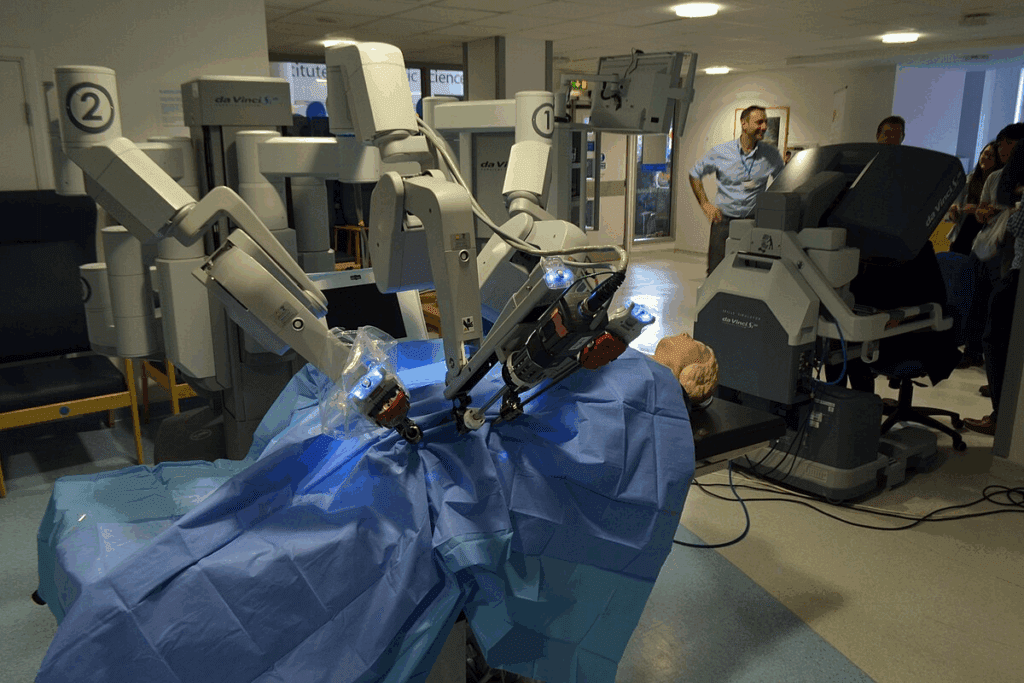Last Updated on November 27, 2025 by Bilal Hasdemir

This rise shows a trend towards using new tech like the da Vinci Surgical System. It aims to make patients’ recovery times shorter and outcomes better. With the cost of systems like the da Vinci surgical robot getting lower, more hospitals are starting to use robotic surgery.
The use of robotic surgery in hospitals has grown a lot in the last ten years. In the US, the number of surgeries done with robots went from 0% to 22% between 2012 and 2022.

Medical technology keeps getting better, and robotic surgery is a big part of that. Hospitals are now using robots in surgeries more often. This change has made operations more precise and less invasive.
Robotic surgery is becoming more popular worldwide. While exact numbers are hard to find, it’s clear many hospitals are using robots. This shows a big trend towards using robotic systems in healthcare globally.
In the US, robotic surgery is very common. About 1,370 hospitals have robots for surgery. This shows US healthcare trusts in the benefits of robotic surgery a lot.
The number of robotic surgeries is growing fast. In 2019, over 883,000 surgeries were done with robots. This shows how much hospitals rely on robotic surgery now.
Looking at the numbers, it’s clear hospitals are using robots more. As the tech gets better, we’ll see even more robotic surgeries. This will make surgery safer and more precise.
Key statistics include:
The world of robotic surgery is changing fast. New tech and more hospitals using robots are driving growth. This change is making surgeries better and safer for patients.
More hospitals are starting to use robotic surgery. This is because it’s more precise and helps patients heal faster. The trend is up, thanks to these benefits.
Key statistics:
Hospitals are likely to keep adopting robotic surgery. Better tech, more surgeon training, and better patient care are key reasons. This growth is expected to keep going.
The robotic surgery market was worth USD 5.16 billion in 2021. It’s expected to hit USD 20.98 billion by 2030, growing 16.84% each year. This growth is fueled by more demand and new tech.
The market spans many regions, with North America leading. Europe and Asia-Pacific are also growing fast. This is thanks to more spending on healthcare and awareness of robotic surgery’s benefits.
| Region | Market Share (%) | Growth Rate (%) |
| North America | 45 | 15 |
| Europe | 30 | 18 |
| Asia-Pacific | 25 | 20 |
There’s a lot of money going into surgical robotics. Companies like Medtronic are buying up tech to improve their offerings. This investment is pushing the field forward.
“The acquisition of Digital Surgery by Medtronic shows how important AI and robotics are in surgery. It’s making procedures more advanced and precise.”
As the market keeps evolving, robotic surgery will become even more vital in healthcare. This is thanks to new tech and more hospitals using these systems.

The da Vinci system leads in robotic surgery, with over 6730 systems in 69 countries. Its reliability, versatility, and value in surgery make it a top choice.
Many hospitals worldwide use the da Vinci system for various surgeries. Its precision and minimal invasiveness are key. Intuitive Surgical’s training programs also help.
It has been used in over 10 million surgeries, showing its big impact on medicine.
There are over 6730 da Vinci systems globally. This shows its popularity and important role in surgery’s future.
The da Vinci system’s success is seen in its clinical outcomes and patient recovery. Its technology keeps improving, making it a top choice for surgeons.
Key success metrics include:
The da Vinci system’s lead in robotic surgery is expected to grow. This is due to its proven success and the increasing need for robotic-assisted surgeries.
The da Vinci Surgical Robot costs between $1.5 million and $2.2 million. This high price is a big factor for hospitals to consider.
The da Vinci Surgical System’s price is high. But, there are other costs too. These include maintenance, training, and supplies.
Cost Breakdown:
| Cost Component | Estimated Cost |
| Initial Purchase Price | $1.5 million – $2.2 million |
| Annual Maintenance | $100,000 – $200,000 |
| Training Expenses | $50,000 – $100,000 |
Hospitals buy the da Vinci Robot hoping for savings. They expect better efficiency, shorter stays, and more patients. Research shows robotic surgery can cut down on hospital time and complications, saving money.
Keeping the da Vinci Robot running costs money. Regular upkeep is key for its long life and best performance. Training for doctors and staff is also vital to get the most from robotic surgery.
Knowing all the costs and possible savings helps hospitals decide on the da Vinci Robot. This careful planning is important for adding robotic surgery to their services.
Robotic surgery is growing fast, helping more patients. It’s used in many surgeries, making them better. This technology brings more precision and control to the operating room.
In urology, robotic surgery is a big deal. It’s used for prostatectomies a lot. This method helps save more tissue, making recovery faster.
More prostatectomies are done with robots now. This shows how popular robotic surgery is in urology.
In gynecology, robotic surgery has changed the game. It’s used for hysterectomies and endometriosis treatments. Robots help surgeons do complex tasks with more skill.
Robotic surgeries in gynecology are faster to recover from. They also have fewer complications, which is good for everyone.
Robots are also used in general surgery. They help with cholecystectomies and hernia repairs. This way, surgeons can do big surgeries through small cuts, making healing quicker.
Mako robotic surgery is a big step forward in orthopedics. It’s great for joint replacement. It lets surgeons plan and do surgeries with great precision, improving patient results.
Robotic joint replacements lead to better implants and happier patients. They last longer and work better.
Mako robotic surgery is very precise. It makes surgeries more consistent. This is key in orthopedics, where small mistakes can be big problems.
Robotic technology helps surgeons be more accurate. This means better care for patients.
New players are entering the robotic surgery market, challenging the old systems. This competition is pushing for more innovation. Now, hospitals have a variety of robotic surgical systems to choose from.
Today, the market offers many robotic surgical systems. Each has its own special features and uses. For example, Medtronic’s Hugo and Stryker’s Mako are making waves in different areas.
New technologies like artificial intelligence (AI) and machine learning (ML) are changing robotic surgery. They help robots learn and get better at their jobs. This means more precise and personalized care for patients.
“The integration of AI and ML in robotic surgery is revolutionizing the field, enabling more precise and personalized surgical care.”
There are now robotic systems made just for certain surgeries. This leads to better results and shorter recovery times. The Galileo Surgery Systems and Rose Robotics Applications are great examples.
Galileo Systems are perfect for minimally invasive surgeries. They offer better visualization and control. This is key for complex surgeries where precision matters most.
Rose Robotics is making big moves in neurosurgery and orthopedics. Their systems aim to improve surgical precision and patient results.
The rise of competing robotic systems is boosting the robotic surgery market. As hospitals adopt these technologies, patients will see better outcomes and quicker recoveries.
Robotic surgery adoption patterns show interesting trends. These trends depend on hospital size and location. The integration of robotic systems into surgical practices is influenced by various factors.
Larger hospitals are more likely to adopt robotic surgery systems. They can invest in expensive technology and train staff. Major medical centers and specialty hospitals lead in this adoption.
Smaller community hospitals face challenges. They have budget constraints and lower surgical volumes. This makes it hard for them to adopt this technology.
| Hospital Size | Adoption Rate |
| Large Hospitals (>500 beds) | 75% |
| Medium Hospitals (200-500 beds) | 45% |
| Small Hospitals ( | 20% |
There’s a big difference in robotic surgery adoption between urban and rural hospitals. Urban hospitals have higher adoption rates. They have more patients and better access to care.
Rural hospitals face challenges. They have limited financial resources and less access to training for robotic surgery.
Teaching hospitals are key in adopting and training robotic surgery. They not only use robotic technology but also train future surgeons.
Studies show teaching hospitals with robotic surgery programs train more surgeons. This training is vital for robotic surgery adoption.
There’s a positive link between robotic surgery adoption in teaching hospitals and research output. Hospitals with robotic surgery programs publish more research papers. They also participate in more clinical trials related to robotic surgery.
Studies show robotic surgery leads to better results for patients. This includes fewer complications and shorter hospital stays. The precision and flexibility of robotic systems help achieve these outcomes.
Robotic surgery is linked to higher success rates. Surgeons can do complex procedures with more accuracy. This leads to better results for patients.
Patients who have robotic surgery often have less pain and recover faster. This is because robotic systems allow for smaller incisions. These smaller cuts cause less damage and help patients heal quicker.
While robotic surgery systems are expensive upfront, they save money in the long run. They lead to lower hospital stay costs and fewer complications.
Robotic surgery has fewer complications than traditional surgery. This is because robotic systems offer better visualization and precision.
Robotic surgery patients usually stay in the hospital less. This cuts down on healthcare costs and lowers the risk of infections.
The future of robotic surgery is bright, with new tech and more hospitals using it. The robotica2023 trends show the market is growing fast.
Systems like the Intuitive Surgical Da Vinci System are leading the way. They help hospitals improve care and cut down recovery times.
New tech and innovations will keep robotic surgery growing. It’s set to change how surgeries are done.
Hospitals will have to weigh the costs and benefits of robotic surgery. How it affects patient care will be key to its future.
Robotic surgery is becoming more common in hospitals. Many places are using systems like the da Vinci Surgical System.
A lot of US hospitals now use robotic surgery. The exact number depends on the hospital’s size and type.
Buying a da Vinci Surgical Robot is expensive. Hospitals also have to pay for upkeep and training.
Hospitals often do urological, gynecological, and general surgery with robots. They also do orthopedic procedures with Mako robotic surgery.
The da Vinci System is a top choice, but Medtronic and Stryker are also popular. They offer unique features and capabilities.
Robotic surgery can lead to better results and faster recovery. It also helps lower healthcare costs.
Bigger hospitals and those in cities are more likely to use robots. This is because they have more resources and access to technology.
Robotic surgery is set to grow with new tech and more hospitals using it. This will lead to better care for patients.
A lot of robotic surgeries are done every year. This number keeps going up as more hospitals start using robots.
Hospitals can see big benefits from using robots. They get better patient results, faster recovery times, and more.
Subscribe to our e-newsletter to stay informed about the latest innovations in the world of health and exclusive offers!